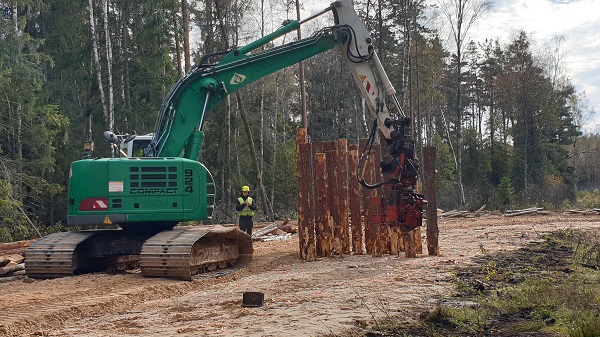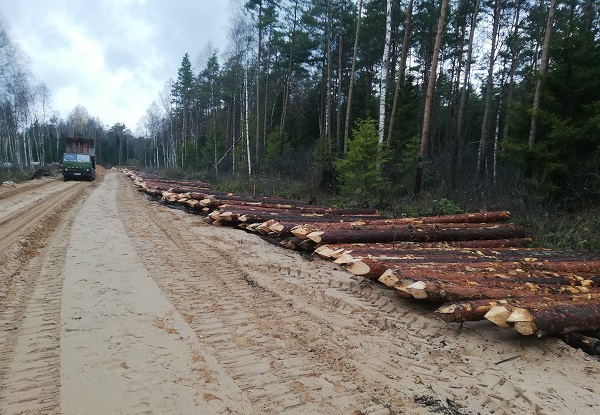In order to ensure the performance of forestry works in particularly difficult, deep peat conditions, JSC “Latvia's State Forests” (LVM) applies an innovative technical solution not previously used in the practice of LVM for the construction of a forest road section – support of the road surface on logs.
In the Limbaži Forest District of Rietumvidzeme Region, in the territory of Brīvzemnieki and Braslava Rural Territories in Limbaži Municipality, the construction of the forest road “Tēvgāršas ceļa turpinājums” is currently underway. The total length of the road is 1.6 km, and a 550-metre-long section of the road is planned to be built in deep peat conditions with a sapropel interlayer.
“In the construction design developed in 2018, technical solutions for improving the durability of the road using a log deck were incorporated. The construction works started in 2019 showed that such solutions cannot be implemented in the specific conditions of unstable soil. Therefore, the construction design was revised, incorporating a technical solution not previously used in LVM practice but used in other countries – the use of round wood piles to overcome unstable soils. The construction design provides for supporting the road surface on a 500-metre-long section on round piles of wood, which have been driven into the ground according to a specific scheme. In this case, it is a triangular pile placement scheme, where the distance between the pile axes is 1 metre,” says Jānis Upens, Forest Infrastructure Manager of LVM Vidzeme Region.
Piles for the construction of the road section are made of coniferous sawlogs, 5.4 metres long and 4.2 metres long with the thin end diameter of 20–24 cm. With an excavator and a special driving head, the piles are driven into the location provided in the construction design.

To ensure the load-bearing capacity of the driven piles, the piles are loaded at random. The loading results are convincing – the load-bearing capacity of the piles is from 6 to 10 tonnes, which exceeds the load-bearing capacity of the designed piles provided in the construction design.
Work on the construction site is relatively smooth. The piles had already been driven on a 320-metre-long section of the road to the ditch crossing. The contractor is starting to build a sand cushion in a particularly durable geotextile.
In parallel with the construction works, a research project led by LVM Development Unit is being carried out on monitoring the use of the pile solution in forest road construction works. The research is performed by a project group of the Forest and Wood Products Research and Development Institute. Within the framework of the research project, equipment and measuring instruments will be set up in the vicinity of the forest road “Tēvgāršas ceļa turpinājums”, which will collect information on possible horizontal and vertical deformations of the structure, groundwater levels, road structure and truck pressure on wooden piles, as well as other measurements. The results of the development project and the experience of construction works in the future will be used by LVM to select technical solutions for the construction of forest roads in particularly difficult conditions, thus overcoming local sections with very low load-bearing capacity.
